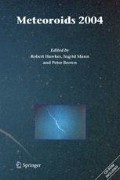Abstract
Meteor radar observations of ionized trails in the Earth’s atmosphere provide observations that do not depend on weather conditions and time of day and provide good statistics for analysis. Further development in the new quasitomographic analysis of the goniometric data of the Kazan meteoric radar has revealed a number of very weak meteoric streams with rates of more than 5–6 meteors per day. In addition to the known large meteor showers, we have found up to as many as 1000 small showers per month that we have named microshowers. We shall operationally define a microshower as the minimal meteoric stream which can be detected with the Kazan meteoric radar while quasitomographic procedures of processing interferometer data are used.
Access this chapter
Tax calculation will be finalised at checkout
Purchases are for personal use only
Preview
Unable to display preview. Download preview PDF.
References
Sidorov, V. V. and Kalabanov, S. A.: 2001, The discrete solution of a quasy-thomography problem for construction of radiant distribution of meteors by results of radar goniometer measurements. Proceedings of “Meteoroids 2001” ESA Publications, Netherlands, pp. 21–27.
Sidorov, V. V. and Kalabanov, S. A.: 2003, Solar Syst. Res. 37(2), pp. 145–155.
Voloshchuk, Yu. I. Kashcheyev, B. L. and Kruchynenko, V. G. (1989). Meteory i meteornoe veshchestvo (Meteors and meteor matter). Kiev: Naukova Dumka 296.
Valsecchi, G. B., Jopek, T. J. and Froeschle’, Cl. (1999a). Meteoroid stream identification: a new approach-I. Theory: MNRAS, pp. 743–750.
Valsecchi, G. B., Jopek, T. J. and Froeschle’, Cl. (1999b). Meteorooid stream identification: a new approach-II Application to 865 photographic meteor orbits, 304: MNRAS, pp. 751–758.
Sidorov, V. V., Kalabanov, S. A., Sidorova, S. V., Filin, I. V. and Filimonova, T.K. Associations of meteor microshowers or as the Kazan radar “sees” radiants on northern celestial hemisphere. Proceedings of “Meteoroids 2004” (in this issue).
Author information
Authors and Affiliations
Editor information
Editors and Affiliations
Rights and permissions
Copyright information
© 2005 Springer
About this chapter
Cite this chapter
Sidorov, V., Kalabanov, S., Sidorova, S., Filin, I. (2005). Microshower Structure of the Meteor Complex. In: Hawkes, R., Mann, I., Brown, P. (eds) Modern Meteor Science An Interdisciplinary View. Springer, Dordrecht. https://doi.org/10.1007/1-4020-5075-5_17
Download citation
DOI: https://doi.org/10.1007/1-4020-5075-5_17
Received:
Accepted:
Publisher Name: Springer, Dordrecht
Print ISBN: 978-1-4020-4374-1
Online ISBN: 978-1-4020-5075-6
eBook Packages: Physics and AstronomyPhysics and Astronomy (R0)

